The fig tree has been cultivated since ancient times and is now grown throughout the world for its fruit, and also as an ornamental plant. In our guide, we’ll officially introduce the fig tree and its characteristics.
We’ll talk through the care requirements for the tree and how to propagate it. Our guide also has info on the pests and diseases that affect Ficus carica, and of course why it makes such a great edible addition to everyone's garden.
More...
Introducing the Fig Tree
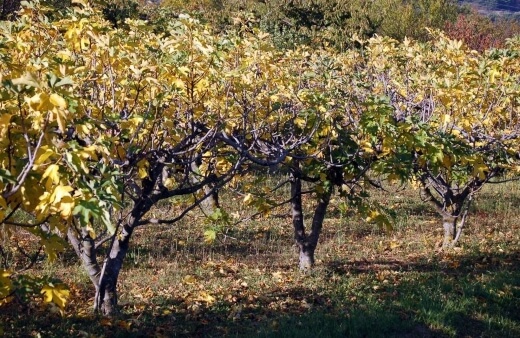
The fig is the edible fruit of Ficus carica, which is a species of small tree in the flowering plant family Moraceae. It’s native to the Mediterranean and western Asia, belonging to the genus Ficus, and containing over 800 tropical and subtropical plant species.
The edible fig is a small deciduous tree or large shrub that grows 7–10 metres tall and has smooth white bark. The fig tree has large leaves and fruit referred to as syconium, which is a type of multiple fruit.
The fruit is tear-shaped, with a green skin that ripens to a purple or brown colour. The milky sap of the green parts of the fig is an irritant to human skin.
Fig Fruit
Figs can be eaten fresh or dried. They can also be processed into jam, rolls, biscuits and other types of desserts. Ripe fig fruit doesn’t transport well, so most commercial production is in dried and processed forms.
Raw figs contain about 80% water and 20% carbohydrates, and are a good source of dietary fibre.
Fig's History
The word fig was first recorded in English in the 13th century. It derives from (Old) French figue, and from Classical Latin ficus (fig or fig-tree).
The common fig tree grows wild in dry and sunny locations and also in rocky locations that are at sea level to 1,700 metres in elevation. Unlike other fig species, Ficus carica does not always need pollination by a wasp or from another tree.
How to Grow Fig Trees in Australia
When it comes to growing fig trees, you just need to focus on providing the right conditions and you end up with fruit that’s juicy and delicious. You wouldn’t describe the tree as pretty, but having a tree that bears fruit is even more valuable.
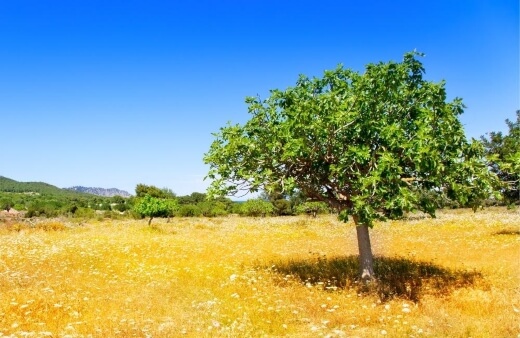
Sunlight Needs
Figs need full sun to grow. If the tree gets less than six to eight hours of direct sun per day, it will produce less figs.
Soil for Fig Tree
The fig tree can grow in a wide range of soils, from light sand to rich organic loams and heavy clay, as long as there is good drainage.
Highly acidic soils should be avoided and the pH should be between 6.0 and 6.5. Figs can handle a bit of salinity, so they are suitable for coastal landscapes.
Temperature and Humidity
Figs are not very hardy. They need a dry climate with light early spring rains. If there’s a wet season while the fruit is ripening, it will affect the crop and the fruits will split and spoil.


Get Your Free Guide:
Master Growing Australian Natives eBook
A Must Have Complete Guide for Every Australian Garden
Get Your Free Guide:
Master Growing Australian Natives eBook
A Must Have Complete Guide for Every Australian Garden
Semi-arid climates with warm temperatures are ideal for growing figs if there is enough water available.
How to Propagate a Fig Tree
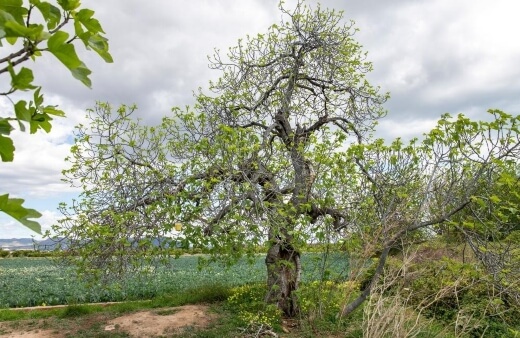
Propagation Fig Tree from Cuttings - Outdoors
Take fig cuttings from small branches that are two to three years old. They should be about 1.3-1.9 cm thick and 20-30 cm long. The bottom end of the cut should be flat and the tip cut should be at a slant.
Treat the slanted end with a sealant to prevent disease. For the flat end, dip it in rooting hormone.Plant the cutting at a depth of 15 cm in a hole that’s 15 cm wide and around 30 cm apart.
Water well but be careful not to over water. The fig cuttings can grow 91-122 cm in a year and the new trees will be ready to transplant for the next season.
Fig tree roots are usually very invasive – it depends on the cultivar, planting location, and the soil quality. Most fig trees growing in optimal conditions spread their roots far and wide.
Sometimes the roots can choke out other plants and can damage sidewalks and driveways. Fig trees do well on the edge of a garden or surrounded by plenty of open space.
Fig Tree Propagation from Cuttings - Indoors
This method is ideal if your spring weather is volatile. You can follow the method above for taking fig cuttings. Line the bottom of a 15 cm pot with newspaper and add 5 cm of sand or potting soil.
You can stand up to four treated cuttings upright in the pot and fill around them with soil. Water the pot well and place a 2-litre bottle with the bottom cut off over the cuttings.
Keep the fig cuttings warm and in a bright spot but make sure they don’t get direct sun. Don’t water unless the soil becomes very dry. A week after you see new growth you can remove the bottle covering.
When the growth is plentiful, you can plant your rooted fig cuttings in larger pots or outdoors when the weather allows. Be sure to keep the transplanted cuttings moist during the summer.
Figs can be successfully grown in pots and the plant size will just adapt. For container grown Ficus carica, replace most of the soil every three years and keep the sides of the pot shaded to prevent overheating in sunlight.
Caring for Fig Trees

Watering Schedule
Fig trees are fairly drought tolerant and don’t need much water for most of the year. They do however like consistently moist soil when there is fruit on the tree.
If there isn’t enough moisture, it will affect the size and quality of the fruit. We recommend mulching with a good organic mulch around the tree’s base to maintain moisture levels.
Fig Tree Fertiliser
Feeding your fig tree is important to keep it healthy and producing enough fruit. Fertilise at least twice a year, especially if the leaves are yellowing.
The perfect time to feed Ficus carica is usually in late winter or early spring and again in late summer when the fruit is ripening. A good choice of fertiliser for Ficus carica is an all-purpose granular slow-release 8-8-8 fertiliser.
Sign up to our AGT newsletter and enjoy gardening tips and ideas for every day.
Common Ficus carica Pests and Diseases
The main problems that fig trees experience happen when the trees are under stress. Good maintenance can usually manage this.
Fig stem borer, mealy bugs, fruit fly, aphids and scale are all insects which can affect the health of a fig tree. The main diseases seen in figs are:
Rust
Look for yellow or white spots on the upper leaves of the plant and reddish to orange blister-like pustules on the underneath of the leaves. You will also notice leaf distortion.
Remove all infected parts of the plant and destroy them. Avoid splashing water onto the leaves, as this can help spread rust. You can dust your plants with sulphur early in the season to prevent infection or to keep mild infections from spreading.
Make sure to space your plants properly for good air circulation. There are many effective rust fungicides you can try and you can ask your local nursery for a recommendation.
Mosaic virus
A mosaic virus is any virus that causes infected plant foliage to have a mottled appearance. You’ll need to remove all infected plants and destroy them.
Monitor the rest of your plants, especially those that were close to infected plants. You need to disinfect your gardening tools after every use. A good tip is to keep a bottle of a weak bleach solution or other antiviral disinfectant to wipe your tools down with.
One of the ways to minimise the risk of mosaic virus is to control your weeds. Some types of weeds become hosts for the disease. When aphids and other insects feed on these plants, they will spread the viruses to your garden plants.
Endosepsis
Endosepsis is spread by the pollinating wasp that enters the green fig to lay eggs. When the wasp dies inside the fig, the fungus develops on its body. Fig endosepsis is also called internal rot, brown rot, eye-end rot, pink rot, and soft rot.
When the fig is still green, the fig will show internal streaks of pink or brown, and sometimes entire flowers are brown. As the figs ripen, the brown streaks turn into rusty spots.
The tree will need to be destroyed and the soil needs to be treated with a fungicide.
The Fig Tree as a Delicious Edible Fruit Tree
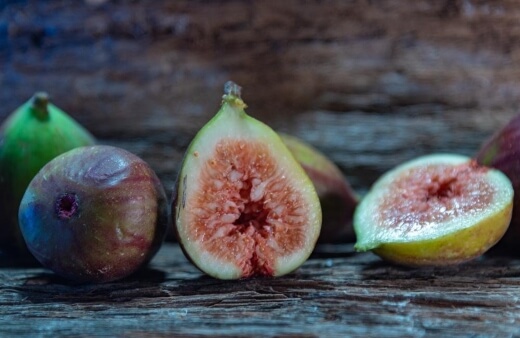
Harvesting Figs
Figs need to ripen fully on the tree before they are picked otherwise they won’t ripen. A ripe fig will be slightly soft, and be sure to harvest the fruit gently to avoid bruising.
Fresh figs don’t keep and you can only store them in the fridge for 2-3 days. Some fig cultivars are delicious when dried. They would need 4-5 days to dry in the sun, 10-12 hours in a dehydrator and then about two days on a car dashboard that has been parked somewhere sunny. Dried figs can be stored for 6-8 months.
How to Eat Figs
Figs taste the best when you eat them straight off the tree. If they are still warm from the sun, even better. The entire fig is edible – you can eat the thin skin, the red or purplish flesh and the tiny seeds.
Some people prefer to peel their figs. Always cut off the stem and first wash the figs and gently pat dry before you serve.
Taste and Texture
Figs have a soft, jammy texture and a super sweet flavour. They are delicious on a grilled pizza with a honey drizzle or you can stuff them with nuts and cheese.
Cooking figs can bring out their sweetness and make them extra juicy. You can put halved figs straight onto a hot grill.
Choosing the Right Figs
When buying figs, look for clean, unblemished skin. If you gently squeeze the fruit, the fig should be soft. The fig’s colour will vary depending on the variety.
Storage and Prep
Keep your figs at room temperature if you plan to eat them within a day or two. You can store them in a plastic bag in the coldest part of the fridge for up to two days and remove them from the fridge at least 30 minutes before eating.
They taste the best at room temperature. Any under ripe figs can be stored at room temperature until the flesh becomes soft.
If you need some bush tucker inspiration, have a look at our bush tucker articles, which cover everything from native fruits and veggies, to herbs and medicinal plants.
Ficus carica Frequently Asked Questions

What are the four different categories of figs?
The categories are:
- Common: doesn’t need pollination to produce fruit
- San Pedro: doesn’t need pollination for the first crop but does for the second crop
- Caduceus/Smyrna: requires pollination to produce fruit
- Capri or Male: usually non-edible figs
How many cultivars of fig are there?
In the different categories of figs you can find over 750 cultivars. The fig actually has more varieties than any other tree crop. Fig cultivars have many unique characteristics including the fruit colour, shape, taste and size.
There are even cold hardy fig cultivars. The fig tree is usually considered a Mediterranean plant but there are many figs that have been cultivated to handle cold climates as low as -20C.
Why are figs considered helpful when it comes to baking?
Figs naturally help hold in moisture in baked goods which keeps them fresher. Fig puree can even be used to replace fat in baked goods.
What is Ficus carica used for?
It has been used in traditional medicine for a wide range of ailments of the digestive, endocrine, reproductive, and respiratory systems.
Another Ficus species we love growing is the Ficus elastica. Find out more about this popular indoor plant by reading our complete rubber plant growing guide.
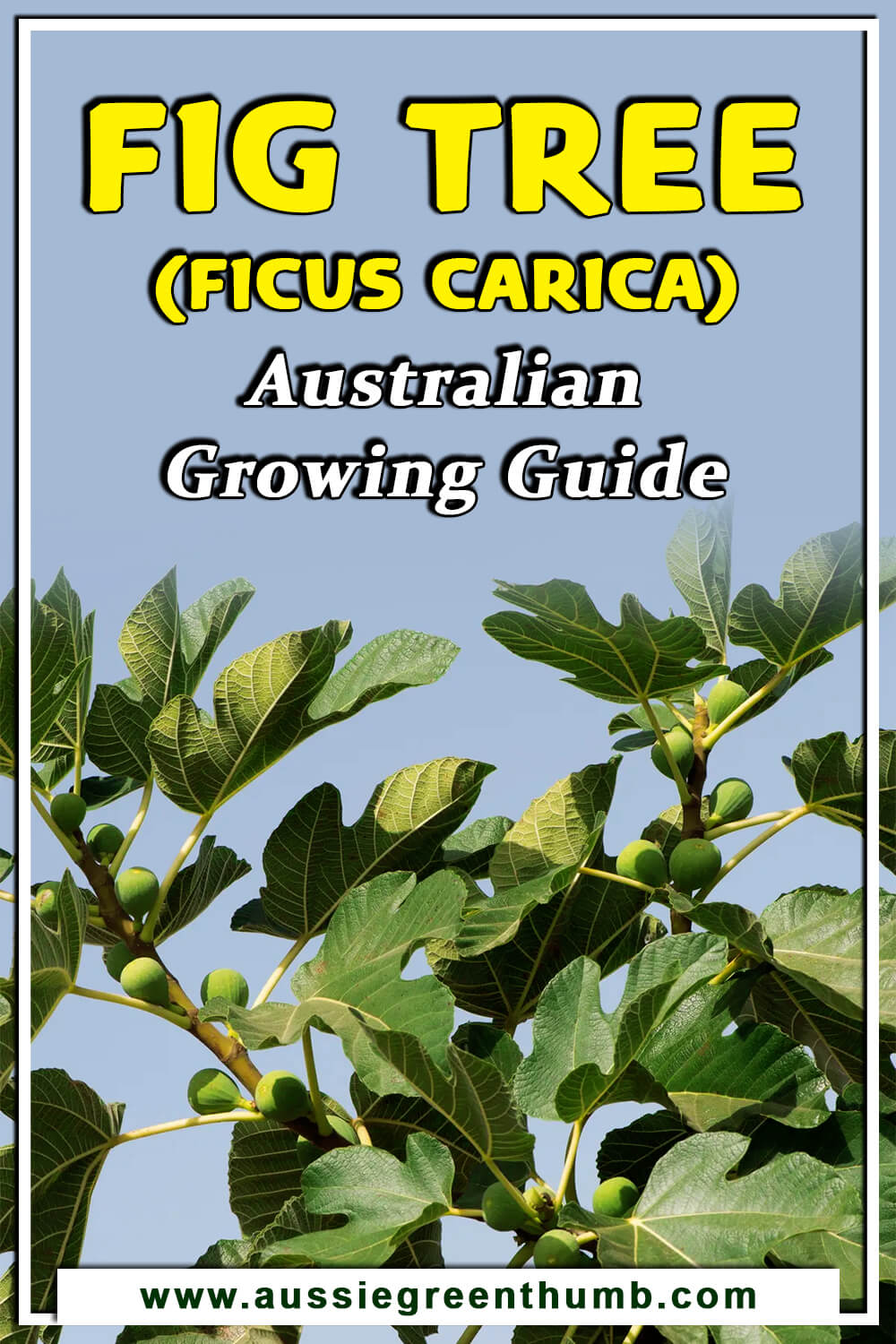
Wrapping Up Our Growing Guide For Fig Trees in Australia
If you’ve ever tasted a sweet fig, you will understand the charm of having your very own fig tree, to produce an abundance of fruit to spice up your kitchen, and your meals. It’s also a great source of fibre - enjoyable and good for you.
The tree itself might not look like much, but the fruit it produces is totally worth it. Ficus carica is not very hardy and can require a bit of maintenance. However, the joy it will bring once the fig tree starts bearing fruit is worth any amount of effort.
You can invite the whole family around to enjoy a fresh crop of figs from your very own tree – pop them on pizzas or enjoy as is as a sweet treat!
Published on May 31, 2022 by Maisie Blevins
Last Updated on February 8, 2025




